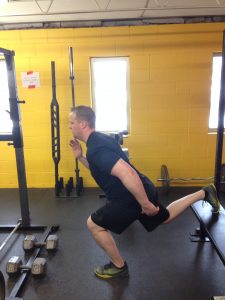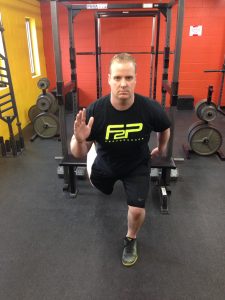Hockey Skating Acceleration
It’s the end of the high school hockey season and our hockey athletes are ramping up their dryland training. One thing that all skaters are looking to do is increase their acceleration. It goes without saying that achieving greater speed skating and running are two different things, as they present different variables. For one skating isn’t going to be as reactive as running (less elastic or rubber band effect). Also, the extension of the hip isn’t going to be just in a horizontal direction, there is going to be a lateral extension as well. The nature of the skating action is also going to hinder basic power production if overuse patterns set in and change the length-tension relationships of the muscles of the lower body. A lot of different factors go into how one can achieve more speed on the ice. Here are just 3 factors that we look to as well as a couple exercise we use to achieve this.
Factor #1:
The fact that skating is less reactive than running means the muscle is going to have to work in a different way. Since there isn’t as much elasticity in the action, plyometric exercises aren’t going to have as great of an effect on performance when it comes to skating. One thing to note is there is a difference between plyometrics and jump training. We still utilize a number of jumping exercises we just aren’t using ones that are trying to enhance the plyometric effect of the muscle. Since the skating stride doesn’t utilize as much eccentric ability as running it becomes more of a pure Rate of Force Development (with no elasticity) (use link to RFD) exercise. Thus, the use of isometric exercises (holding) become very beneficial in increasing skating speed. Being able to hold and stabilize specific positions better will give the athlete a more solid foundation to extend their leg with more power. Think about it from this standpoint would you rather run and jump in sand or on cement? Cement will give you a more solid base to exert the power. Here is an exercise I like to use to help to create that base.
Exercise: Split Squat Hold
Purpose: The purpose of the split squat hold is to develop strength in the bottom position of the skating stride. A secondary benefit is that it is a great way to teach the athlete’s body what position you want it to be in.
How to Perform: Assume a position where you have your back leg on a box between 16-18 inches high. When you step out from the box your back leg hip flexor (the front of the hip) should be going through a slight stretch. The front leg should be in an athletic position where when looking at it from the side the shoulders, hips, and toes are in alignment. From the front view, everything from the shoulders through feet should be square to one another.
Common incorrect positioning to watch for: Position is key with this exercise, not just from the beginning but also through the duration of the hold. Often times I see people trying to perform this exercise way too long which causes the athlete to actually change the position from that they started in. The key is to force the athlete to hold the starting position and not change or adjust it. Common tendencies will be to allow the front knee to come in, shift the weight of the front leg back causing too much of a vertical shin (knee not in align), and twisting the hips or shoulders one way or another to take tension off of the hip muscles.


Factor #2:
The multi-directional nature of the extension of the skating stride has to be taken into account in order to enhance skating speed. The fact that it is a combination of horizontal and lateral power can’t be overlooked. Having the correct combination will lead to the greatest speed outputs on the ice. More times than not I find that the athlete needs more horizontal thrust or power to increase their speed. However, this isn’t always the case. Many times, I find that the athlete needs to enhance their lateral power output as well. In either case, I like the use of 1 leg directional jumps (horizontal and lateral) to start with.
Exercise: One Leg Multi-Directional Jump
Purpose: The purpose of the one leg multi-directional jump is to enhance single leg power in the specific directions that skating requires.
How to Perform: Starting on one leg standing straight up and down, coil the hips back and down to the depth of the skating stride, it should be in the same position as the front hip of the split squat hold. From this position begin to extend from the hip to the knee, and through the ankle as explosively as possible to jump as far as possible in the intended direction. Since power is the emphasis of this drill I have the athlete land on two legs to ensure proper stability. If the athlete can’t correctly land the jump you’ll need to work on landing mechanics to ensure safety and on ice performance (uncontrolled power does very little for on ice performance).
Common mistakes to watch for: Once again the position and stability of that position that the athlete coils down to is vital. You shouldn’t see any twisting or knee shifting throughout this exercise. If the position changes while or once getting to the coiled position mostly likely it is a yielding strength issue. If alignment changes once the athlete begins to jump out of the bottom position, it is most likely an activation or concentric strength issue. Making sure the hips initiate the jump are key for maximum power production. Ensure these are correct before looking at the distance the athlete is jumping.
Factor #3
Hockey is a chaotic sport, you need to be able to go in any direction at any time. But during most games and practices maximum power output occurs in the linear direction. Thus, practices and most dryland training emphasize this. The problem with this is it creates huge amounts of overused patterns, mostly in the glute medius (lateral part of the hip) which becomes overly tight. When this occurs it tends to lead to not being able to take in force at that muscle. In order to keep correct joint positioning, muscles need to be able to take in or stabilize the force created by other actions. In this case, if the glute medius becomes overly tight you’ll tend to see the athlete’s knees come together, which creates weaker positions for power production. In addition, the groin muscles will become more relaxed (shutoff), thus exposing to the chance of injury, which why I feel there are so many groin injuries in hockey. Thus, training should always be an evaluation of proper alignment. Here is a blog I did talking about the 3 proper alignment keys hockey should entail.



